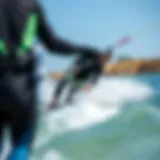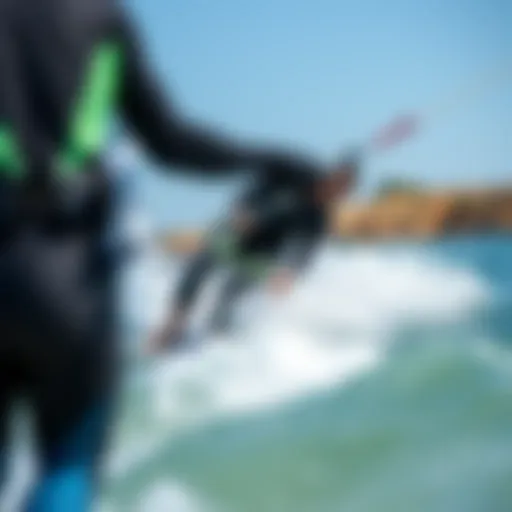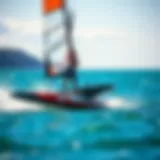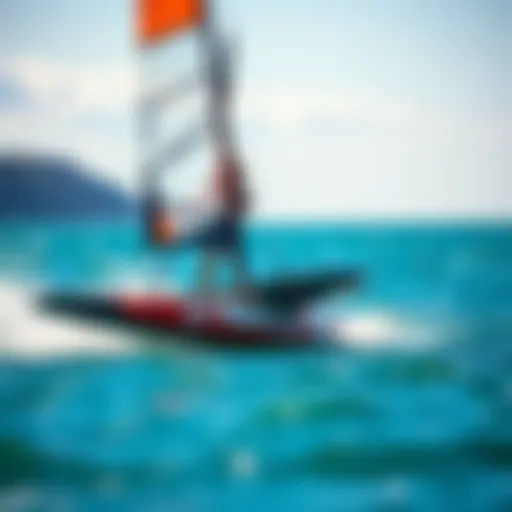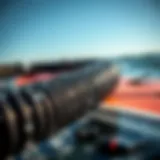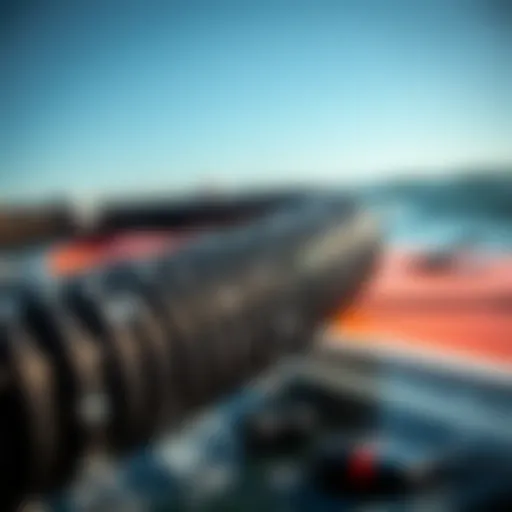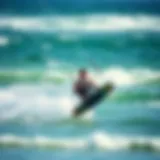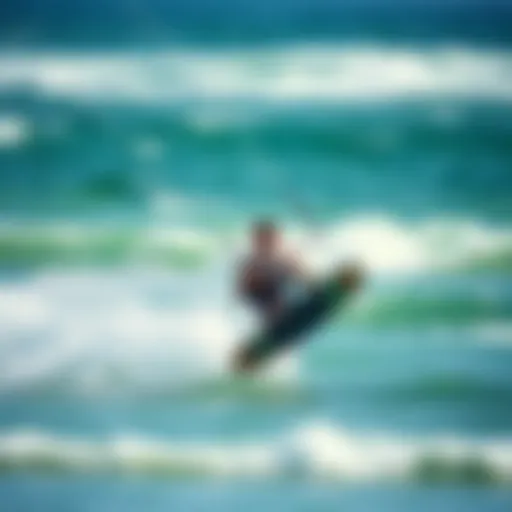Mastering Kiteboard Kites: Selection, Use, and Care Guide


Intro
Kiteboarding is more than just a sport; it’s a unique blend of thrill and technique that captures the imagination of water enthusiasts. The kite, serving as the heart of the setup, can make or break your entire experience on the water. Selecting the right kiteboard kite not only enhances performance but also ensures safety. Whether you're easing into the sport as a beginner or pushing your limits as a seasoned rider, understanding the nuances of kite selection, usage, and maintenance is vital. This guide aims to navigate these waters, providing clarity and insight into the various dimensions of kiteboarding.
Techniques for Kiteboarding Enthusiasts
The journey into kiteboarding can be exhilarating yet intimidating. Here, we break down essential techniques for both beginners and advanced riders to ensure they harness the wind effectively and make the most of every session.
Beginner Techniques
Starting out, it's crucial to get the basics right. Here are some techniques that can help newbies find their footing on the water:
- Understanding Wind: Recognizing wind patterns is vital. Learning how to read the wind conditions can prevent mishaps. Look for flags and local trees; they can give you hints about wind direction.
- Body Dragging: Before jumping on the board, practice body dragging. This involves using the kite to pull your body across the water while remaining connected to your harness. It helps in building confidence with kite control.
- Water Start: Once comfortable with the kite, mastering the water start is your next step. Position the board in front of you and edge downwind while pulling on the back hand. Timing and subtle movements are essential here.
Advanced Maneuvers
As riders progress, the thrill often turns to mastering complex maneuvers. Here are a few advanced techniques:
- Jumping and Tricks: Once you’re comfortable with your jumps, consider working on aerial tricks. Understanding kite height and positioning is key, along with practicing your landings.
- Transitions: Perfecting your transitions is crucial for fluidity. Learning to switch directions smoothly while maintaining speed can elevate your game significantly.
- Riding Upwind: As you progress, the ability to ride upwind will allow you to cover more distance. Strong edging and body positioning play significant roles in achieving this.
"Kiteboarding isn’t just about the ride; it’s about mastering the elements and pushing boundaries."
Equipment Reviews
Having the right gear makes a considerable difference in performance. This section reviews some of the pivotal equipment that kiteboarders rely on in their adventures.
Kite Reviews
Different types of kites serve various riding styles and conditions. Popular options include:
- C-Kites: Known for their performance and precise handling, they are a favorite among freestylers.
- Bow Kites: These offer fantastic stability and are excellent for beginners due to their easy relaunch capabilities.
- Hybrid Kites: Striking a balance between performance and usability, hybrids cater to diverse riding styles.
Board Reviews
Choosing the right board can dramatically affect your riding experience. Consider the following types:
- Directional Boards: Ideal for downwind rides and those who enjoy surf-style riding.
- Twin Tip Boards: Versatile and perfect for beginners, these boards are symmetrical and easy to ride in both directions.
- Foil Boards: For advanced riders seeking a different level of experience, foil boards offer unique sensations by lifting above the water’s surface.
For further reading, consider visiting sources like Kiteboarding Wikipedia or Britannica for more detailed insights.
Prelude to Kiteboarding Kites
Kiteboarding has grown from a niche water sport to a mainstream activity that attracts many enthusiasts from all walks of life. At the heart of this exhilarating sport are the kites themselves, which play a critical role in determining performance, safety, and enjoyment. Choosing the right kite can make or break a session on the water, thus understanding the various aspects of kiteboarding kites is essential for anyone looking to get serious about the sport.
The design of a kite is more than just aesthetic appeal; it encompasses a series of intricate components that work together to create the flying experience. This is vital for both beginners and seasoned kiteboarders, as each choice can significantly impact handling characteristics and performance. With a plethora of options available, inexperienced kiteboarders may find themselves overwhelmed with choices. Here is where a comprehensive overview becomes instrumental, as it demystifies the different types of kites available and elucidates how their design features influence performance.
When choosing a kite, several factors come into play, such as skill level, preferred riding style, wind conditions, and even personal preferences. It’s not just about getting any kite that looks flashy; the right equipment can enhance not only performance but also safety and comfort during the ride.
Moreover, safety has to be at the forefront of every kiteboarding enthusiast's mind. Basic knowledge about the equipment is paramount. Understanding how different kites control in the wind can mean the difference between a thrilling ride and a potential mishap.
In this article, we will take a deep dive into various aspects of kiteboarding kites, from their basic design components to the advanced features found in modern models. We will also explore maintenance practices that can prolong the life of your kite, ensuring it remains in optimal condition for many exhilarating sessions ahead.
Ultimately, equipping oneself with the right knowledge about kiteboard kites will inevitably lead to better riding experiences and improved skills. Let's get into the nitty-gritty of kiteboarding kites, so you can choose wisely and ride the waves with confidence.
Understanding the Basics of Kite Design
To truly grasp the nuances of kiteboarding, understanding the fundamental elements of kite design is paramount. This section elucidates the intricacies of how various components contribute to the overall performance, stability, and handling of kites. Learning the ropes of kite design can elevate a rider's experience, enabling better decision-making when it comes to selecting and utilizing kites in diverse conditions.
Components of Kite Design
Leading Edge
The leading edge of a kite is its foremost component that plays a crucial role in aerodynamics. Its primary purpose is to split the wind, creating a stable airflow over the canopy. The shape and rigidity of the leading edge are vital; a stiffer leading edge enhances performance by offering greater lift and stability. This rigidity is often achieved through the use of inflated bladders or rigid frames.
Within the context of kiteboarding, a well-designed leading edge is essential for both beginners and experienced riders. Beginners benefit from its stability, allowing for easier handling and control, while seasoned kiteboarders appreciate the performance gains that come from advanced designs. However, having a too rigid leading edge can sometimes lead to difficulties in steering.
Trailing Edge
Moving down the kite, the trailing edge functions as the back section, crucial for airflow management. The design of the trailing edge influences how the kite cuts through the wind and reacts upon release. A properly crafted trailing edge reduces drag, allowing for smoother flights and improved maneuverability.
This part of the kite is often where you find interesting features such as adjustable flaps or small notches that fine-tune performance. Such enhancements make the trailing edge a popular area for innovation. However, a trailing edge that is too loose or poorly designed can derail a kite's performance, making it a critical aspect of kite design to consider.


Struts and Canopy
The struts and canopy together form the body of a kite, providing structure and shape. Struts are the vertical components that support the canopy, helping maintain its profile in the air. A well-built canopy material contributes significantly to the kite's overall performance, offering a delicate balance between durability and weight.
Typically made from ripstop nylon or similar fabrics, the canopy's design is crucial for maximizing lift and allowing for an efficient control response. The interplay between struts and canopy needs to be harmonized; otherwise, issues such as deformation during flight may arise. Riders should be aware of the trade-offs involved: a lighter kite may be more responsive but less durable, while heavier fabrics might yield more resilience but could feel sluggish on the water.
Types of Kite Shapes
Flat kites
Flat kites are known for their versatility and ease of use. Often recommended for beginners, these kites provide stable flight characteristics in lighter winds. Their design allows for a broad wind range, making them a popular choice as they perform adequately in various conditions. However, they may lack the aggressive performance features, making them less ideal for advanced tricks. The simplicity of a flat kite can be a double-edged sword—while beginner-friendly, it may not satiate the appetite for performance in a seasoned rider.
Delta kites
Delta kites are characterized by their triangular shape which enhances their ability to climb quickly in the air. This design allows for efficient power generation while still offering excellent stability. The delta shape contributes to better performance in gusty winds, making them a popular choice among intermediates who wish to push their limits. However, the quick lift can come with a learning curve, as beginners might find them a bit tricky to handle if they haven't mastered the basics yet.
C-shape kites
C-shape kites are particularly notable for their precise handling response and performance characteristics. Their design enables significant lift and a direct connection with the rider, allowing for dynamic movements and jumps. These kites are often favored by advanced riders for tricks and unhooked maneuvers. However, their performance-oriented nature demands more skill and control, which can pose a challenge to those still honing their craft.
In summation, understanding these foundational aspects of kite design enables kiteboarders to not just ride but also fully comprehend how to manipulate their gear for optimal results on the water. Learning about each component gives riders the confidence to explore different kites tailored to their unique riding styles and skill levels.
Types of Kiteboard Kites
When it comes to kiteboarding, understanding the various types of kites is crucial. Different kites serve distinct purposes, catering to specific conditions, riding styles, and skill levels. In this section, we will explore the three primary types of kiteboard kites: Bow kites, C-kites, and Hybrid kites. Each can facilitate a unique experience on the water, and knowing these characteristics can significantly enhance a kiteboarder's performance and enjoyment.
Bow Kites
Bow kites are characterized by their wide, flat shape and a slightly arched leading edge. This design allows for better lift and a larger wind range, making them suitable for both beginners and seasoned kiteboarders. The versatility of bow kites lies in their ability to create significant power without the need for a steep angle of attack. A key advantage of bow kites is that they possess a high degree of depower. This means that when you pull the control bar in, the kite’s power is reduced, allowing for greater control in gusty winds.
Some specific features that make bow kites attractive include:
- Easy relaunch: With their design, bow kites can be easier to relaunched from the water after a mishap, which is a crucial feature for beginners.
- Stability in the air: They provide a stable experience, which can build confidence in new riders.
- Versatile performance: Since they can handle a wider range of wind speeds, bow kites give users room to push their limits as they gain experience.
C-Kites
Next up are C-kites. These are a tad different, featuring a more traditional design that includes a distinct 'C' shape. C-kites are well-known for their performance features, especially when it comes to tricks and jumps. The tension in the canopy allows for direct feedback to the rider, making them a favorite among freestyle kiteboarders.
Key characteristics of C-kites include:
- Responsive handling: Riders receive immediate input from the kite, allowing for precise navigation and trick execution.
- Great for kite loops: C-kites excel in performing aggressive maneuvers, enabling advanced riders to push the envelope.
- Less depower: Compared to bow kites, they offer less depower, requiring experienced technique and awareness in variable wind conditions.
While C-kites are undoubtedly fun and exhilarating, they are generally recommended for intermediate or advanced riders who can handle the nuances of their performance.
Hybrid Kites
As the name suggests, hybrid kites blend components from both bow and C-kites, aiming to capture the best of both worlds. They usually have a more versatile design, focusing on stability while still offering good performance for tricks. Hybrid kites are designed to be user-friendly and adaptable to a range of conditions, making them a preferred option for kiteboarders who embrace a mix of styles.
Features of hybrid kites include:
- Balanced performance: They provide a good mix of lift and feedback, making them accessible for a broader range of riders.
- Handling versatility: Riders can experience smooth control in various wind conditions, tailoring their kiteboarding experience.
- Ideal for progression: As they easily accommodate tricks and carving, hybrid kites can aid in skill progression for both novices and intermediates.
In summary, selecting the right type of kiteboard kite hinges on understanding your riding style, capabilities, and personal preferences. Whether you lean toward the stability and ease of bow kites, the responsiveness of C-kites, or the hybrid's versatility, there's a kite out there that caters specifically to your kiteboarding needs.
Choosing the Right Kite for Your Skill Level
Selecting the appropriate kite is crucial for ensuring a pleasurable and safe kiteboarding experience. Whether you are a novice just starting out or an advanced rider pushing the limits, understanding the kite that fits your current level is essential. Choosing the right kite not only influences your performance on the water but also impacts your learning curve, progression, and overall enjoyment of the sport. It’s about matching your skills with a kite that complements your abilities and meets your personal style.
Novice Considerations
Size and Stability
For beginners, size and stability of the kite are paramount. A larger kite can catch more wind and provide more power, which helps in learning how to get up on the board. However, if it’s too big, it might become overwhelming. Stability in a kite refers to how well it handles in varying wind conditions. A stable kite tends to be easier to control, especially for those who are just learning the ropes.
The advantage of selecting a larger and stable kite is that it offers confidence to novice riders. If you find yourself in a situation where the wind picks up, a stable kite can help keep you airborne without throwing you into unexpected maneuvers. On the flip side, if the kite is too large for your skill level, it can become a bit of a beast to handle, resulting in falls or difficult landings that might discourage a novice.
Ease of Use
Ease of use plays a significant role for newbies in this sport. You want to hop on and start enjoying without the headaches of overly complicated setups or control systems. A kite that’s known for its user-friendly features will be a good fit for someone still learning the basics. Riders want straightforward control systems to allow them to focus on riding rather than wrestling with the gear.
An easy-to-use kite can typically feature intuitive control bars, simplified launching and landing techniques, and responsive handling. As a beginner, getting accustomed to your kite's behavior in different winds will be much easier if you are not bogged down by complexity. That said, these easier options often have less performance capability, which is something to keep in mind as you advance.


Intermediate and Advanced Considerations
Performance Features
Once you’ve mastered the basic skills, it’s time to consider performance features. High-performing kites often come with specialized designs that enhance speed, agility, and lift. For intermediate and advanced riders, characteristics such as aspect ratio, shape, and construction materials play a vital role in how well the kite will perform under a variety of conditions.
Riders looking to progress will appreciate kites with lightweight materials, which contribute to better maneuverability and responsiveness. These kites will often allow for higher jumps and more tricks, making them a popular choice among seasoned kiteboarders. However, the very features that enhance performance can also make kites harder to control, presenting a challenge for those still honing their skills.
Customization
Customization is another aspect that becomes increasingly important for experienced kiteboarders. It allows riders to fine-tune their gear according to personal preferences and riding styles. This might mean adjusting the percentage of the kite's power, altering the line lengths, or experimenting with different setups in terms of airflow and shape.
Ability to customize a kite not only enhances performance but also lets the rider connect more intimately with their gear. This level of personalization, however, does present a learning curve. Newer riders shouldn’t feel pressured to dive into customization until they have a solid understanding of how their kite behaves in various environments and wind conditions.
"Choosing the right kite is more than just about the kite itself; it's about understanding your abilities and maximizing your potential on the water."
Performance Characteristics of Kiteboard Kites
Understanding the performance characteristics of kiteboard kites is paramount for anyone wishing to get the most out of their experience on the water. Performance can often be the decisive factor that influences how well a kite behaves in varying conditions. A kite that excels in performance will help a rider execute maneuvers with greater ease, making it essential to appreciate how specific traits affect handling, power generation, and overall ride experience.
Wind Range and Handling
When it comes to kiteboarding, the wind range is not just a buzzword; it represents a kite's versatility across various wind conditions. Each kite has an optimal wind range which indicates the best speed and control it provides, but what's worth knowing is that some kites can thrive in both low and high winds.
For experienced riders, understanding how to operate within this range can unlock new levels of performance.
- Low Wind Handling: In light winds, larger kites tend to be more forgiving and provide better lift. They need to be handled with a softer touch to maintain control. If you're a novice, a kail in this range can give you more time to react without feeling overwhelmed.
- High Wind Handling: These are usually compact and stable kites. In heavier winds, noticeable changes in kite dynamics occur. The control becomes sharper, and riders need to be aware that wind gusts can send them airborne with little warning. For instance, a C-kite will feel more responsive compared to a bow-kite, which may seem more sluggish in challenging conditions.
In short, knowing your kite's wind range not only informs you when to take to the water but also how to adapt your style accordingly.
Lift and Power Generation
The kite's ability to generate lift and power defines how exhilarating your ride will be. In kiteboarding, lift is essential for jumping and executing tricks. But there’s more to it — it’s about how the power is distributed and how easily a rider can harness that power into speed and height.
A few critical aspects to consider:
- Shape Impacts Performance: The design of the kite matters. A C-kite, for example, is renowned for its strong lift, making it a favorite for jumpers. On the flip side, Bow kites have a wider wind range and allow for smoother power delivery, which can be beneficial for those new to the sport.
- Power Zones: Understanding the kite’s position in relation to the wind (commonly referred to as the "Window") can optimize lift. A rider will usually find a more dynamic lift by keeping the kite at the edge of the wind window, allowing for quicker acceleration and height during jumps.
"Power is nothing without control." - This adage holds true in kiteboarding. Anyone can generate power, but harnessing it effectively is what separates the novices from the seasoned riders.
Safety Protocols When Using Kiteboard Kites
Safety is paramount when it comes to kiteboarding. Implementing proper protocols reduces the risk of accidents, ensuring a safer and more enjoyable experience on the water. Understanding these safety measures not only protects the rider but also those around them. A good grasp of safety protocols empowers kiteboarders to make informed decisions, fostering a community where well-being is prioritized.
Pre-Flight Checks
Before launching into the great blue yonder, it’s crucial to conduct thorough pre-flight checks. This can be likened to a pilot performing a checklist before takeoff; every little detail counts. Here are essential considerations:
- Inspect Your Gear: Check the condition of your kite, lines, control bar, and harness. Look for any signs of wear, tears, or frays that could cause failure.
- Verify Line Length and Tension: Make sure your lines are even and securely attached. Unequal lengths can lead to mishaps mid-flight, which are best avoided.
- Environment Assessment: Always assess the wind conditions. Is it too strong for your skill level? Are there any obstructions like trees or buildings nearby?
- Wear Protective Equipment: A helmet, impact vest, and suitable wetsuit can make a significant difference in protecting against injuries.
“Safety is not a gadget but a state of mind.” – Eleanor Everettt
Proper pre-flight checks can save your day or even your life. Taking a moment to double-check ensures all is in order before you leap into the wind.
Understanding Kite Control Systems
Kite control systems are the backbone of managing your kite in the air. A solid understanding of these systems can greatly enhance your ability to control the kite, especially in challenging conditions. Here’s what to grasp:
- Control Bar Functionality: The control bar is crucial for steering the kite. Pulling on one side induces a turn, and knowing how to properly use it is fundamental.
- Safety Systems: Modern kites come with safety features like quick-release systems that allow for fast depowering of the kite. Familiarize yourself with these before hitting the water.
- Launching and Landing Techniques: Know how to effectively launch and land your kite. Miscommunication during these stages can lead to serious issues. Getting solid ground support can prevent mishaps.
Ultimately, a kite's control system determines how well you maneuver in the air. Understanding how these components work together not only aids in executing impressive stunts but also keeps safety where it should be: front and center.
Kite Maintenance and Care
Kite maintenance and care are often overlooked aspects of kiteboarding that can significantly impact a kite's longevity and performance. Just like any sporting equipment, kites require careful attention to ensure they remain in top-notch condition. Maintaining your kite not only helps in preserving its physical integrity but also enhances your riding experience and reduces the chances of accidents due to equipment failure. Neglecting maintenance can lead to costly repairs and even safety hazards on the water.
Cleaning Your Kite
Cleaning your kite after each session is essential. Saltwater, sand, and other debris can accumulate on the kite's surface and in its seams, potentially compromising its structural integrity and aerodynamics. Here’s how to clean your kite effectively:
- Rinse with Fresh Water: After a day on the water, immediately rinse your kite with fresh water to remove any salt, sand, or dirt. This is a crucial step that will prevent corrosion and material degradation.
- Gently Scrub: For stubborn spots or any residue, use a soft brush or cloth to scrub gently. Avoid using harsh chemicals, as they can weaken the kite material. A mild soap can be used, but rinse thoroughly afterward to avoid any residue.
- Inspect for Damage: While cleaning, it’s a good time to inspect for any tears, punctures, or wear on the seams. Identify any issues early to avoid more significant problems down the line.


"A stitch in time saves nine."
Taking care of minor damages quickly can save you from more severe repairs in the future.
Storage Guidelines
Proper storage is just as important as cleaning since how you store your kite can also affect its longevity:
- Store Dry: Always ensure your kite is completely dry before folding and storing it. Moisture can lead to mold and mildew, especially if stored for extended periods.
- Use a Bag: Invest in a quality storage bag specifically designed for kite kites. This helps in protecting the material from dust and direct sunlight, both of which can cause fading and degradation.
- Avoid Extreme Temperatures: Store your kite in a cool, dry place away from direct sunlight. Extreme temperatures can affect the materials used in kite construction, leading to brittleness and cracking.
- Flat Storage: When possible, lay your kite flat rather than crumpling it up. This minimizes creases and folds, which can stress the material and seams.
Emerging Trends in Kiteboarding Equipment
In the ever-evolving landscape of kiteboarding, staying abreast of emerging trends is crucial for both enthusiasts and professionals alike. This section sheds light on the advancements that are changing the game, enhancing performance, and improving overall user experience. As kiteboarding gear becomes more sophisticated, understanding these developments not only aids in making informed purchasing decisions but also fosters a greater appreciation for the sport. The recent shift toward high-tech materials and innovative technology has opened the door to exciting possibilities, promising a revolution in how kiteboarders approach their craft.
Advancements in Materials
The materials used in kite construction are a fundamental aspect that directly impacts performance, durability, and safety. Recent trends emphasize lightweight yet robust options, pushing the boundaries of what kite manufacturers can achieve.
One significant advancement is the use of Dyneema fibers, known for their exceptional strength-to-weight ratio. Kites made from Dyneema are not only lighter but also possess greater resistance to wear and tear. This is crucial for kiteboarders who frequently engage in high-intensity riding, where the stress on equipment can lead to quick degradation.
Moreover, advancements in lamination techniques have resulted in stronger seams and connections, which enhance the overall integrity of the kite. For instance, subpar seams can lead to leaks, causing the kite to underperform. It’s worth considering that a well-constructed kite can mean the difference between a smooth ride and a potential mishap.
Additionally, the introduction of materials that repel salt and freshwater has drastically reduced the maintenance time required, allowing riders to focus on enjoying their time on the water rather than fussing over rigging and maintaining their gear.
"The right materials can truly elevate the kiteboarding experience, melding innovation with performance in ways we are just starting to explore."
Smart Kite Technology
Advancements in technology have delved into the realm of smart kite solutions. These innovations integrate electronics into kites, providing valuable data to riders that can enhance their skills and safety. Smart kites are designed with built-in sensors that gather data on wind speed, direction, and even rider performance metrics.
For instance, kites equipped with GPS and accelerometers can offer detailed insights into jumping height, speed, and distance. Such statistics can profoundly influence a rider’s training regimen, enabling tailored practices that focus on areas requiring improvement. In the long run, this not only improves individual performance but uplifts the community by fostering a culture of data-driven growth.
Furthermore, smart technology can enhance safety. Features such as automatic depower systems that engage during specific situations potentially prevent disastrous outcomes in adverse weather conditions. Staying connected on the water through mobile applications allows riders to track their performance and share data with friends or instructors, creating a collaborative learning environment.
As kiteboarding continues to embrace technological advancements, the trends toward smart gear are not merely optional; they could very well become standard.
Closure
Understanding emerging trends in kiteboarding equipment empowers riders to make better choices, improve skills, and enjoy the sport with a greater sense of security. Advancements in materials and smart kite technology are not just enhancements; they are reshaping how we connect with wind and water, paving the way for the next generation of kiteboarding enthusiasts.
Top Kiteboarding Locations for Enthusiasts
When it comes to kiteboarding, the location can make or break the experience. Choosing a spot where conditions align with your skill set and desired level of adventure is crucial. Not only do these locations provide the perfect environment for maneuvering your kite, but they also offer stunning landscapes and vibrant local cultures that enhance the overall kiteboarding experience. Here, we delve into some of the top kiteboarding locations across the globe, each boasting their own unique charm and conditions suitable for kiteboarders of all skill levels.
North America
North America is home to some of the most diverse kiteboarding locations, ranging from the sandy beaches of Florida to the windswept shores of the Pacific Coast.
- Key Locations: Places like Cape Hatteras in North Carolina are particularly renowned for their steady winds and shallow waters, making it an ideal spot for novices and experts alike. The Outer Banks, in particular, have become a hotspot for kiteboarding, thanks to their consistent breeze and warm weather.
- Benefits: The reliable wind patterns combined with local kiteboarding shops and schools make for an excellent community atmosphere. Whether you're looking to learn or perfect advanced tricks, you have access to instructors and rental gear almost year-round.
- Considerations: While the weather conditions are great, it is essential to be aware of changing tides and local regulations which might affect your kiting hours. Understanding the specific wind seasons will also yellp you plan your visit appropriately.
Europe
Europe's vast coastline offers an endless variety of kiteboarding spots, each with its own unique appeal.
- Key Locations: The beaches in Tarifa, Spain, are often called the wind capital of Europe. It's not just the wind that draws people; the vibrant nightlife and stunning landscapes enhance the overall experience. Another favorite is Lake Garda in Italy, which provides flat water for beginners and challenging conditions for experienced riders.
- Benefits: Europe is famous for its diverse landscapes, from the stunning fjords of Norway to the sunny beaches of the Mediterranean. This variety means you'll find the right spot suited for your skill level, whether you're seeking a more leisurely ride or challenging yourself on big waves.
- Considerations: It's important to stay informed about local kiteboarding championships or events, which often attract large crowds and can influence your kiting experience. Always respect local rules and fellow water sports enthusiasts as well.
Asia-Pacific
The Asia-Pacific region presents some exotic kiteboarding opportunities that can leave you breathless with their beauty and adventure.
- Key Locations: Bali, Indonesia, has firmly established itself as a global kiteboarding destination with its consistent winds, warm water, and remarkable scenery. Moreover, the beaches of Boracay in the Philippines offer stunning backdrops and clear waters ideal for both beginners and advanced riders alike.
- Benefits: The culture and hospitality of the local communities add a unique flavor to your kiteboarding experience. Most spots also offer lessons, gear rental, and local kiteboarding schools, providing a nurturing environment for newcomers.
- Considerations: Keep in mind that during the rainy season, conditions can change quickly. Familiarizing yourself with local wind patterns and potential hazards is helpful for a safe outing. Be sure to also recognize environmental initiatives, as responsible kiteboarding ensures these beautiful locations remain pristine for future generations.
The right location can transform an average kiteboarding day into an unforgettable adventure. Take your time to explore various spots and see what fits your style!
Finale
In the vast world of kiteboarding, having a solid grasp on kiteboard kites is crucial for elevating both skills and enjoyment on the water. This article has unpacked essential elements, from kite selection and performance characteristics to maintenance practices, providing a comprehensive overview for both budding enthusiasts and seasoned pros alike.
One key takeaway is understanding that not all kites are created equal; factors such as wind conditions, rider skill, and personal preferences can significantly affect the kite's performance. Choosing the right type of kite—be it a bow kite for its forgiving nature or a C-kite for agile maneuverability—can shape a rider’s entire experience. Furthermore, the knowledge of maintenance and care cannot be overlooked. Regular inspections, cleaning, and proper storage not only extend the kite’s lifespan but also contribute to safer riding experiences.
"The right kite can make or break a riding session. Take your time in understanding the options—it's worth it!"
Moreover, as we see advancements in materials and smart technology entering the market, staying informed about the latest trends is fundamental. Innovations can offer enhanced performance, durability, and ease of use, all critical in a sport that is fundamentally about embracing the elements.
Thus, as you set out on your kiteboarding journey, remember that knowledge is your first line of defense against the unpredictability of water and wind. Assess your skill level, maintain your gear with care, and explore different kite types to find what fits you best. The right combination of equipment and understanding can turn a simple day on the water into an unforgettable adventure.
For further reading on kiteboarding insights and updates, check out resources at Wikipedia, Britannica, or communities on Reddit. Such platforms offer a treasure trove of shared experiences and tips to keep you informed and inspired.


